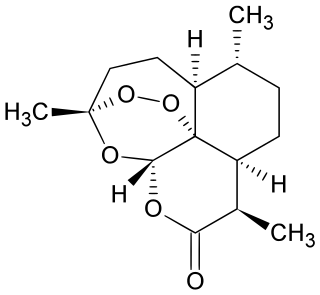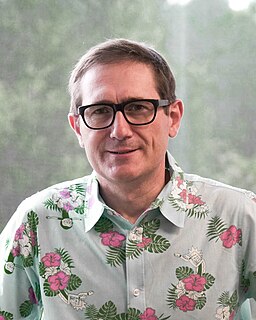
Artemisinin and its semisynthetic derivatives are a group of drugs used against malaria due to Plasmodium falciparum. It was discovered in 1972 by Tu Youyou, who shared the 2015 Nobel Prize in Physiology or Medicine for her discovery. Treatments containing an artemisinin derivative are now standard treatment worldwide for P. falciparum malaria as well as malaria due to other species of Plasmodium. Artemisinin is isolated from the plant Artemisia annua, sweet wormwood, a herb employed in Chinese traditional medicine. A precursor compound can be produced using a genetically-engineered yeast, which is much more efficient than using the plant.

Tropical medicine is an interdisciplinary branch of medicine that deals with health issues that occur uniquely, are more widespread, or are more difficult to control in tropical and subtropical regions.

Global health is the health of populations in the global context; it has been defined as "the area of study, research and practice that places a priority on improving health and achieving equity in health for all people worldwide". Problems that transcend national borders or have a global political and economic impact are often emphasized. Thus, global health is about worldwide health improvement, reduction of disparities, and protection against global threats that disregard national borders. Global health is not to be confused with international health, which is defined as the branch of public health focusing on developing nations and foreign aid efforts by industrialized countries. Global health can be measured as a function of various global diseases and their prevalence in the world and threat to decrease life expectancy in the present day.

Open research is research conducted in the spirit of free and open-source software. Much like open-source schemes that are built around a source code that is made public, the central theme of open research is to make clear accounts of the methodology freely available via the internet, along with any data or results extracted or derived from them. This permits a massively distributed collaboration, and one in which anyone may participate at any level of the project.

Pyrimethamine, sold under the brand name Daraprim among others, is a medication used with leucovorin to treat the parasite diseases toxoplasmosis and cystoisosporiasis. It is also used with dapsone as a second-line option to prevent Pneumocystis jiroveci pneumonia in people with HIV/AIDS. It was previously used for malaria but is no longer recommended due to resistance. Pyrimethamine is taken by mouth.
The Structural Genomics Consortium (SGC) is a public-private-partnership focusing on elucidating the functions and disease relevance of all proteins encoded by the human genome, with an emphasis on those that are relatively understudied. The SGC places all its research output into the public domain without restriction and does not file for patents and continues to promote open science.

The Drugs for Neglected Diseases initiative (DNDi) is a collaborative, patients’ needs-driven, non-profit drug research and development (R&D) organization that is developing new treatments for neglected diseases, notably leishmaniasis, sleeping sickness, Chagas disease, malaria, filarial diseases, mycetoma, paediatric HIV, and hepatitis C. DNDi's malaria activities were transferred to Medicines for Malaria Venture (MMV) in 2015.

Neglected tropical diseases (NTDs) are a diverse group of tropical infections which are common in low-income populations in developing regions of Africa, Asia, and the Americas. They are caused by a variety of pathogens such as viruses, bacteria, protozoa and parasitic worms (helminths). These diseases are contrasted with the big three infectious diseases, which generally receive greater treatment and research funding. In sub-Saharan Africa, the effect of these diseases as a group is comparable to malaria and tuberculosis. NTD co-infection can also make HIV/AIDS and tuberculosis more deadly.
The Novartis Institute for Tropical Disease (NITD) is a Singapore-based tropical disease research institute created through a public-private partnership between Novartis and the Singapore Economic Development Board. Research at NITD focuses primarily on developing novel small molecule therapies for tropical infectious diseases that are endemic to the developing world, particularly dengue fever, malaria and tuberculosis.
Mycetoma is a chronic subcutaneous infection caused by aerobic actinomycetic bacteria (actinomycetoma) or fungi eumycetoma. While most cases of mycetoma occur in Sudan, Venezuela, Mexico, and India, its true prevalence and incidence are not well-known. It appears most frequently in people living in rural areas, particularly farmers and shepherds. It is listed by the World Health Organization (WHO) as a neglected tropical disease.
The Center for World Health & Medicine (CWHM) was a not-for-profit drug discovery research center which was established in 2010 by Saint Louis University. The staff consisted entirely of former pharmaceutical industry scientists with diverse skills and experience in advancing new therapies for testing in human clinical trials. Working with investigators at the university and with collaborators from around the world, the Center’s primary mission was to discover and enable clinical development of affordable new medicines for unmet medical needs with an emphasis on orphan diseases, neglected diseases, and diseases of poverty. Collectively, these diseases have enormous socioeconomic consequences, as they disproportionately affect the most vulnerable populations including the poor, infants and children.

ChEMBL or ChEMBLdb is a manually curated chemical database of bioactive molecules with drug-like properties. It is maintained by the European Bioinformatics Institute (EBI), of the European Molecular Biology Laboratory (EMBL), based at the Wellcome Trust Genome Campus, Hinxton, UK.

Sean Ekins is a British pharmacologist and expert in the fields of ADME/Tox, computational toxicology and cheminformatics at Collaborations in Chemistry, a division of corporate communications firm Collaborations in Communications. He is also the editor of four books and a book series for John Wiley & Sons.

Fenarimol, sold under the tradenames Bloc, Rimidin and Rubigan, is a fungicide which acts against rusts, blackspot and mildew fungi. It is used on ornamental plants, trees, lawns, tomatoes, peppers, eggplants, cucumbers and melons. It is mainly used to control powdery mildew. It works by inhibiting the fungus's biosynthesis of important steroid molecules.
Open Source Drug Discovery is a Council of Scientific and Industrial Research, India (CSIR)-led Team India Consortium with global participation. offering a collaborative drug discovery platform for neglected tropical diseases like leishmaniasis, which draw limited attention of research-based pharmaceutical enterprises. This program has a global community with over 7500 participants from 130 countries comprising researchers, academia, students, industries, educational institutions and so on. Anyone who is committed to the discovery of drugs for neglected diseases in an open source mode can participate in the program. OSDD functions by bringing together experts from diverse backgrounds to focus on discovering and developing affordable drugs for tropical infections.
Peggoty Mutai is a Kenyan chemist. Born in Kericho, her interests include medicinal chemistry, in particular working with the search for new treatments against parasitic worms.

Danoprevir (INN) is an orally available 15-membered macrocyclic peptidomimetic inhibitor of NS3/4A HCV protease. It contains acylsulfonamide, fluoroisoindole and tert-butyl carbamate moieties. Danoprevir is a clinical candidate based on its favorable potency profile against multiple HCV genotypes 1–6 and key mutants (GT1b, IC50 = 0.2–0.4 nM; replicon GT1b, EC50 = 1.6 nM).. Danoprevir has been evaluated a open-label, single arm clinical trial in combination with ritonavir for treating COVID-19 and favourably compared to lopinavir/ritonavir in a second trial.

Alice Elizabeth Motion is a British chemist, science communicator, and lecturer at the School of Chemistry, University of Sydney. She is the founder of the Breaking Good project which encourages high school and undergraduate students to take part in research that can benefit human health. In 2018, the Breaking Good project was a finalist on the Google.org Impact Challenge.
Neglected tropical diseases in India (NTDs) are a group of bacterial, parasitic, viral, and fungal infections that are common in low income countries but receive little funding to address them. Neglected tropical diseases are common in India.
Jonathan Baell is an Australian medicinal chemist. He is a research professor in medicinal chemistry at the Monash Institute of Pharmaceutical Sciences (MIPS), the Director of the Australian Translational Medicinal Chemistry Facility and a Chief Investigator at the ARC Centre for Fragment-Based Design. He is also the President of the International Chemical Biology Society. His research focuses on the early stages of drug discovery, including high-throughput screening (HTS) library design, hit-to-lead and lead optimization for the treatment of a variety of diseases, such as malaria and neglected diseases.












